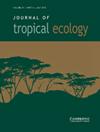新加坡以外来物种为主的新森林中,枯落物磷的升高减少了枯落物和土壤有机质库的数量
IF 1
4区 环境科学与生态学
Q4 ECOLOGY
引用次数: 0
摘要
利用不具代表性的模型和枯落物类型,对枯落叶周转率的估算通常仅限于早期分解阶段。在热带次生林中,尤其是以外来物种为主的新森林中,枯落叶周转率的特征仍然很不明显。本研究使用 Weibull 停留时间模型估算了新加坡四种森林演替类型中原地落叶的年周转率。幼林次生林和老林之间的落叶周转率和养分动态存在差异。特别是,在新森林中,每年通过落叶回收的磷是原始森林的三倍,而在所有森林演替类型中,原地落叶的损失量最大,估计为每年 92.8%,平均停留时间为 176 天,导致落叶库的规模是原始森林的三分之一。我们的研究结果表明,树种组成和树种特异性效应决定了在不同森林演替类型和林分中观察到的落叶周转和养分动态变化,而树种丰富度、树冠结构、土壤养分水平和小气候则不是预测因素。总之,我们的研究深入揭示了人类改造的热带景观中日益以新型森林为特征的枯落物更替,这可能会导致地表枯落物和土壤有机碳库的减少。本文章由计算机程序翻译,如有差异,请以英文原文为准。
Elevated litterfall phosphorus reduces litter and soil organic matter pools in exotic-dominated novel forests in Singapore
The estimation of leaf litter turnover is often limited to early-stage decomposition using unrepresentative models and litter types. In tropical secondary forests, particularly exotic-dominated novel forests, the characterisation of litter turnover remains poor. This study estimated the annual turnover of in-situ leaf litter across four forest successional types in Singapore using a Weibull residence time model. Litter turnover and nutrient dynamics diverged between young secondary and old-growth forests. In particular, within novel forests, annual phosphorus return via leaf litterfall was three times that of primary forests, while the mass loss of in-situ leaf litter was highest among all forest successional types, estimated at 92.8% annually with a mean residence time of 176 days, resulting in a litter pool size a third that of primary forests. Our findings suggest that tree species composition and species-specific effects shaped the observed variations in litter turnover and nutrient dynamics across forest successional types and forest stands, whereas tree species richness, canopy structure, soil nutrient levels, and microclimate were found to be non-predictors. Taken together, our study provides an insight into litter turnover in human-modified tropical landscapes increasingly characterised by novel forests, potentially leading to a reduction in surface litter and soil organic carbon pools.
求助全文
通过发布文献求助,成功后即可免费获取论文全文。
去求助
来源期刊

Journal of Tropical Ecology
环境科学-生态学
CiteScore
2.10
自引率
0.00%
发文量
44
审稿时长
18-36 weeks
期刊介绍:
Journal of Tropical Ecology aims to address topics of general relevance and significance to tropical ecology. This includes sub-disciplines of ecology, such as conservation biology, evolutionary ecology, marine ecology, microbial ecology, molecular ecology, quantitative ecology, etc. Studies in the field of tropical medicine, specifically where it involves ecological surroundings (e.g., zoonotic or vector-borne disease ecology), are also suitable. We also welcome methods papers, provided that the techniques are well-described and are of broad general utility.
Please keep in mind that studies focused on specific geographic regions or on particular taxa will be better suited to more specialist journals. In order to help the editors make their decision, in your cover letter please address the specific hypothesis your study addresses, and how the results will interest the broad field of tropical ecology. While we will consider purely descriptive studies of outstanding general interest, the case for them should be made in the cover letter.
 求助内容:
求助内容: 应助结果提醒方式:
应助结果提醒方式:


